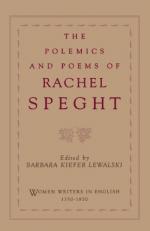|
This section contains 1,806 words (approx. 7 pages at 300 words per page) |

|
SOURCE: Walker, Kim. “‘This worke of Grace’: Elizabeth Middleton, Alice Sutcliffe, Rachel Speght, and Aemilia Lanyer.” In Women Writers of the English Renaissance, pp. 101-23. New York: Twayne Publishers, 1996.
In the following excerpt, Walker discusses how Speght's “Dreame,” one of the poems in her Mortalities Memorandum, intends to show that women have the same ability as men to move from ignorance to knowledge.
Rachel Speght is more radical in the strategies she employs to make herself a place in an overwhelmingly masculine literary tradition. In what Elaine Beilin describes as the “mythmaking” of the “Dream” narrative prefixed to Speght's Mortalities Memorandum (1621), this middle-class London woman explicitly claims access to what she calls “Eruditions garden.”1 The main poem of Mortalities Memorandum is a meditation on death comparable to that of Alice Sutcliffe. In the stanzaic form later employed by both Sutcliffe and Elizabeth Middleton (different only in its rhyme...
|
This section contains 1,806 words (approx. 7 pages at 300 words per page) |

|


